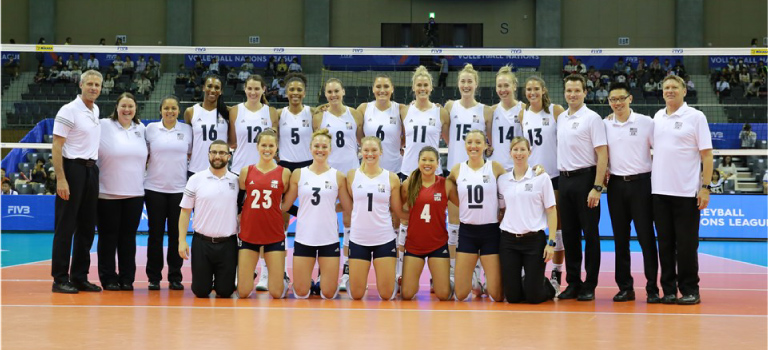Alumna Spotlight: Kara Kessans Working as a Physical Therapist and Athletic Trainer for USA Volleyball

Kara Kessans (USC ’06, bottom row, far right) works with elite volleyball players on the U.S. Women’s National Indoor Team.
The USC Division of Biokinesiology and Physical Therapy’s DPT program prepares students to become leaders in physical therapy, shaping the future of health care. Kara Kessans ’06 is an alumna who illustrates this type of leadership working with elite players on the U.S. Women’s National Volleyball Team.
Her academic courses and clinical experiences at USC were pivotal in helping her create a path to this position of leadership and impact.
“USC provided a great environment for learning,” Kessans said, “with well-known professors, opportunities in a variety of disciplines to develop our skills, research that drives the practice of physical therapy, and the tools for lifelong learning.”
Outside of the classroom, Kessans had the opportunity to enhance her movement analysis skills while working on an independent research project with Drs. Susan Sigward and George Salem in the Musculoskeletal Biomechanics Research Lab. This opportunity to work on research enhanced her clinical skills by giving her more detailed insight into how the body moves. It also gave her the opportunity to present her research at an international conference and contribute to peer-reviewed publications.
“Our professors are very passionate and dedicated to their work, and this bleeds into how they teach,” Kessans said. “This passion and dedication helped me develop into who I am now.”
We sat down with Kessans to discuss her triumphs in the field of physical therapy, her academic and professional experiences, and how she is applying her studies in her career.
Describe your time at USC and how it prepared you to enter the world of professional sports — especially women’s volleyball.
Once I graduated from USC, I was able to start my career in sports at a Division 1 school in the Big Ten Conference as well as work in the physical therapy clinic on campus. This opportunity allowed me to work with different sports teams and learn the intricacies of each sport and the movement demands of high level athletes — preparing me for this next chapter in my career. So, with this experience and the strong foundation from USC, I was able to take my career to the professional level working with elite volleyball players.

What are the kinds of things that physical therapists working with traveling athletes need to take into consideration?
With a concentrated game schedule, athlete recovery is critical for optimal performance in all competitions. All of our travel is international, so the athletes are constantly on airplanes and buses for long periods of time. This challenges the recovery process. Optimizing recovery is one of my top priorities. I use compression therapy, electrical stimulation, soft tissue mobilization, massage, cold and hot whirlpools, and pool workouts to help with this. There isn’t a set recipe since every trip and athlete is different. This is where I draw on my foundational knowledge from USC and my experience with high-level athletes to identify the optimal course of action for each athlete.
What are some aspects of the DPT program in particular that stood out to you as a student?
I loved my time at USC. The professors, teaching assistants and clinical faculty did a fantastic job of molding our minds to becoming the best clinicians we could be. They allowed me to explore the world of research as well as took the time outside of their work to help me practice my skills or review difficult concepts. My class felt like a big family.

What piece of advice would you offer to someone who wants to work with elite athletes?
Never stop going for your dreams. Take every volunteer opportunity that you can to get you where you want to be. It makes your background that much more diverse, and it helps you in terms of communicating with others and having those contacts later in life. Talk to professionals and ask them: “This is what I want to do. How do I get there?” Find someone who’s where you want to be and talk to them and hear their story. Figure out what will make your career what you envision.
Last updated November 2018


